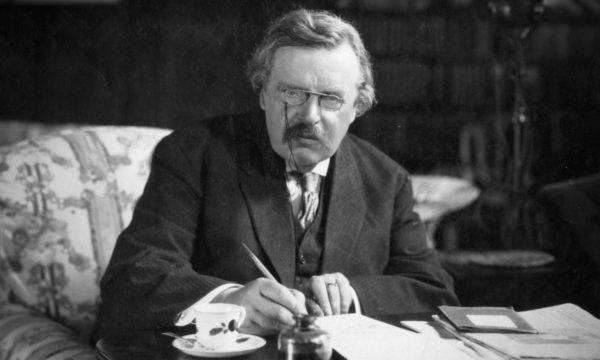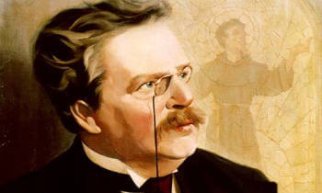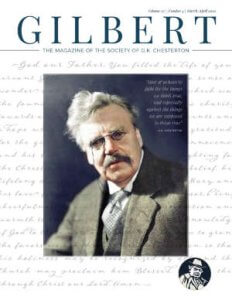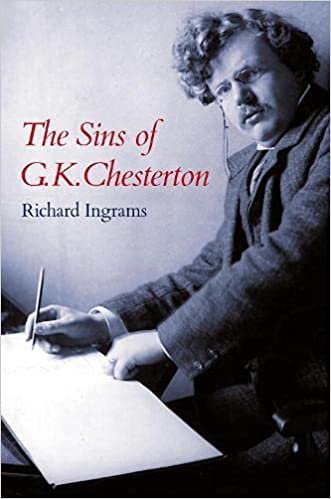The Sins of G.K. Chesterton
A Review
Brandon Vogt and Nancy Carpentier Brown
We congratulate Richard Ingrams for writing a new biography of G.K. Chesterton, especially one that reveals new material that has never been known before about G.K. Chesterton. Unfortunately, the new material that Ingrams has found is only new to himself, and it is new because it is novel and untrue.
For example, Ingrams believes that Cecil Chesterton, Gilbert’s brother, was or might have been the inspiration behind the Father Brown mysteries (he was not—that was Fr. John O’Connor.) Ingrams claims that Cecil Chesterton died at the age of 32, which was seven years before his actual death. Ingrams says the Distributist League boasted only a “few hundred” members, when in fact there were thousands. Ingrams states that Gilbert’s close friend and official biographer, Maisie Ward, was married to Wilfred Sheed, who was actually her son, a discovery which undoubtedly would have alarmed her. Glaring, basic errors such as these expose the sloppiness of Ingrams’ project.
But worse than the errors of fact are the errors of inference. For instance, on page 76 the reader will discover that, “Chesterton’s tragedy was that he accepted, without questioning, almost all of Belloc’s political opinions.” But just prior to this, on page 72, we read that Gilbert “inhabited his own imaginative world in which Belloc had no say and which, in any case, he was not particularly interested in.” One of the primarily claims in this book is that Gilbert was influenced by Belloc’s sins. But just four pages apart, Ingrams tells us Gilbert was both irresistibly impressionable and immune to Belloc’s influence.
This guilt-by-influence tactic is Ingrams’ main weapon in The Sins of G.K. Chesterton. He tries to show how Belloc and Cecil directly shaped Gilbert’s prejudices, but also how Gilbert was indirectly swayed by Ada Jones. Ada had tremendous influence over Cecil, by whom, according to Ingrams, Gilbert was “controlled and directed.” Ada, Cecil’s future wife and thus Gilbert’s sister-in-law, is Ingrams’ major reference throughout the book. Ada used the trade name J. (John) K. (Keith) Prothero and requested people call her Keith. Her book, The Chestertons, has been discounted as unreliable by most Chesterton scholars, and Ingrams himself describes Ada as “prone to erratic judgements and inconsistency as was Cecil.” Nevertheless, Ingrams relies heavily upon the erratic and inconsistent Ada.
In addition to guilt-by-influence, Ingrams also employs an argument from silence. He says one must “read between the lines” of any book on Chesterton, because none of the actual lines reveal the hidden truths Ingrams has discovered about Gilbert’s “sins.” He reminds the reader that, “What people don’t say is often more significant than what they do. If Chesterton said nothing about the disputes and schisms that erupted in 1935, that silence is itself an indication of his feelings.” This opens up a whole new world of possibilities in the realm of Chesterton scholarship. We can now research and reflect upon what Chesterton didn’t say and find whole new mountains of information about what he must have believed.
But let us focus on the titular “sins” of G.K. Chesterton that Ingrams appears so eager to expose. What are they? Well, the first is Chesterton’s supposed anti-Semitism, an old accusation against him. In Chesterton’s time, the term anti-Semitism referred to the radical hatred of a race, usually Jews, despite the loose interpretation of the word Semite, which technically refers to any person of ancient southwestern Asian descent, including the Akkadians, Phoenicians, Hebrews, and Arabs. Most people recognized the word to mean a racial hatred of the Jewish, or Hebraic, people. This is precisely why Gilbert Chesterton could repeatedly write during his lifetime that he was not an anti-Semite. He did not hate any person or any people, including and especially the Jews.
But what does the word mean today? Today, post Holocaust, post-Chesterton’s lifetime, it means a criticism of any Jewish person, or even a legitimate criticism of a person who happens to be Jewish. It falls under the umbrella of racial prejudice, which can include simply noting the race of a person as a descriptor. For example, if a bank is robbed by a middle Eastern man, it is generally acceptable to say that a person robbed a bank, but some consider it racist (and perhaps even sexist) to observe that an Arab man robbed a bank. We must not describe the man as having a hooked nose and a turban (even if he did) and we must not allow the imagination to guess at his race. But this was not the case in Chesterton’s time. People were more relaxed about racial descriptions and features.
That said, we agree with Ingrams in one respect: Chesterton did at times speak insensitively about broad groups of people, such as bankers, politicians, scientists, literary reviewers, educators, the Irish, the Prussians, even the British, and yes, the Jews. He jabbed and joked with a broad brush, and engaged in stereotyping, actions today we could consider inconsiderate. But such jabs were not “sins,” and they certainly were not acts of racism. Insensitive, sure, unfair overgeneralizations, perhaps—but not sins.
It’s also worth noting that virtually all these insensitive remarks came before 1922, which is when Chesterton converted to the Roman Catholic faith. It would be interesting to do a study of his language before and after 1922 to see if there was a difference. In fact, almost every instance Ingrams cites of apparent anti-Semitic language is pre-1922.
But returning to those “sins” of Chesterton. A more apt title for this book would have been The Sins of Cecil Chesterton, Ada Jones Chesterton, and Hilaire Belloc, for Ingrams spends far more pages in this book describing their sins, and tenuously trying to connect them to Gilbert, than on Gilbert’s own personal shortcomings. But for the sake of space, let’s comment here only upon the G.K. Chesterton information.
About the Authors

Brandon Vogt
Brandon Vogt is a bestselling author of ten books and the founder of ClaritasU. He works as the Senior Publishing Director for Bishop Robert Barron’s Word on Fire Catholic Ministries.
He is the founder of Chesterton Academy of Orlando, a classical high school grounded in the Catholic faith, and serves as President of the Central Florida Chesterton Society. He lives with his wife and eight children on Burrowshire, a small farm outside of Orlando.

Nancy Carpentier Brown
Nancy Carpentier Brown works as Director of Communications for the Society of G.K. Chesterton. She is the author of numerous Chestertonian titles, including: The Father Brown Reader: Stories from Chesterton, The Father Brown Reader II: More Stories from Chesterton, Chesterton’s The Blue Cross: Study Edition, and A Study Guide for G. K. Chesterton’s St. Francis of Assisi. She also wrote the first biography of G.K. Chesterton’s wife, Frances Chesterton, titled The Woman who Was Chesterton.





